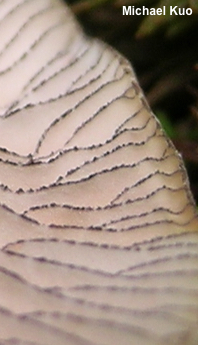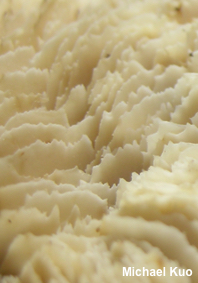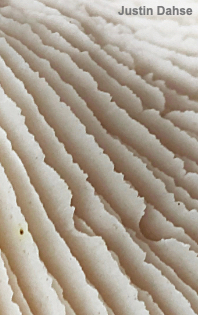|





|
|

Saw-Gilled Mushrooms
by Michael Kuo, 14 September 2025
Mushrooms with saw-toothed gills like those in the illustrations to the left are not necessarily closely related, but they do form a nice, manageable group for identification purposes. While virtually any gilled mushroom can develop gills with jagged edges due to environmental factors, some species consistently manifest saw-toothed gills, throughout development. Many of these belong to the genera Lentinus, Neolentinus, and Lentinellus—but there are saw-toothed mushrooms in other genera, and Lentinus contains straight-gilled species, as well.
Key to 22 North American Saw-Toothed Mushrooms 
| 1. | Cap shoehorn-shaped, appearing folded around the stem's axis like an asymmetrical funnel. | 2 |
| 1. | Cap variously shaped but not shoehorn-shaped as above. | 3 |
| 2. | Associated with woody debris (especially in urban settings) but not typically growing directly from logs or stumps; flesh rubbery and tough; odor mealy; spores inamyloid; impressive metuloid cystidia abundant. | |
| 2. | Growing directly from stumps or logs; flesh tough but not rubbery; odor not distinctive; spores amyloid; cystidia absent, or inconspicuous and boring. | |
| 3. | Stem well developed and more or less central; spores amyloid or inamyloid. | 10 |
| 4. | Usually appearing on twigs and small branches (of both hardwoods and conifers); cap small, to 35 mm wide; stem present and lateral. | Lentinellus flabelliformis |
| 4. | Usually appearing on larger branches, stumps, standing deadwood, etc.; cap variously sized; stem present or not. | 5 |
| 5. | Usually appearing on the wood of conifers. | 6 |
| 5. | Usually appearing on the wood of hardwoods. | 7 |
| 6. | Usually appearing in summer or fall, throughout North America; spores 3–4 µm long; odor strong and fruity. | |
| 7. | Distributed in western North America, appearing primarily on the wood of thinleaf alder; mature cap up to 3 cm wide. | Lentinellus subargillaceus |
| 7. | Widely distributed in North America, appearing on the wood of various hardwoods; mature cap usually wider than 3 cm. | 8 |
| 8. | Dried flesh demonstrating a brown to brownish, inamyloid or dextrinoid reaction to Melzer's or Lugol's; flesh separated by a black line or not. | 9 |
| 9. | Mature cap fairly small (under 6 cm across), usually featuring a patch of brown, velvety tomentum that spreads from the point of attachment toward the edges with development; generally distributed in temperate and subtropical zones; skeletal hyphae present. | |
| 9. | Mature cap usually larger than 6 cm, not usually featuring a patch of velvety tomentum; generally boreal in distribution; skeletal hyphae lacking. | Lentinellus vulpinus |
| 10. | Spore print pink; gill edges darker than the faces by maturity. | 11 |
| 10. | Spore print white or only very slightly pinkish; gill edges colored like the faces throughout development. | 12 |
| 11. | Cap black to bluish black, fading to gray; odor mealy; widely distributed in North America. | |
| 11. | Cap dull grayish, fading to pale yellowish gray; odor foul but not mealy; distributed east of the Rocky Mountains. | |
| 12. | Growing from the ground, or from forest litter. | 13 |
| 13. | Widely distributed in North America, appearing under pines (species of Pinus, with bundled needles), decomposing needle litter; cap to 6 cm across, reddish brown when fresh; stem often club-shaped; at least some spores (often many) dextrinoid. | |
| 13. | Distributed only in the Rocky Mountains, appearing under various trees as mycorrhizal associates; cap variously sized; stem club-shaped or not; spores amyloid. | 14 |
| 14. | Cap to 6 cm across, grayish brown to gray, bald or a little fibrillose. | |
| 14. | Cap to 13 cm across, bright yellow and scaly. | |
| 15. | Growing from the wood of conifers (including railroad tracks, fence posts, and other treated conifer lumber). | 16 |
| 15. | Growing from the wood of hardwoods. | 18 |
| 16. | Cap to 15 cm across, whitish with small brown to brownish scales; ephemeral partial veil present on button-stage specimens; widely distributed in North America, appearing only on lumber from the Rocky Mountains westward, but east of the Rocky Mountains appearing either on lumber or on natural wood. | |
| 16. | Cap variously sized, reddish brown to pinkish, brownish, or pale brown, either without scales or with large appressed scales; partial veil absent; distributed from the Rocky Mountains westward, on natural wood. | 17 |
| 17. | Cap to 8 cm across, pinkish to dull reddish brown or brownish, without scales; stem surface smooth or finely fibrillose; often on the wood of Sitka spruce. | Neolentinus kauffmanii |
| 17. | Cap to 30+ cm across, pale brownish, with large appressed scales; stem surface scaly; often on the wood of ponderosa pine. | |
| 18. | Cap surface smooth or finely fibrillose. | 19 |
| 19. | Cap with a broadly depressed center; odor sweet and anise-like; stem base usually with a patch of reddish brown fuzz; spores cylindric and inamyloid. | Lentinus suavissimus |
| 19. | Cap with a central, navel-like depression; odor not distinctive; stem base naked or with brownish fuzz; spores ellipsoid and amyloid. | |
| 20. | Cap small (to 3 cm), developing brownish ridges that extend from the margin nearly to the center, creating a pleated appearance; spores 13–15 µm long. | |
| 20. | Cap usually larger than 3 cm when mature, not becoming ridged and pleated; spores under 10 µm long. | 21 |
| 20. | Found in riverine ecosystems, fruiting from frequently soaked wood; widely distributed east of the Great Plains and in the Southwest; gills white or whitish. | |
| 20. | Not limited to riverine ecosystems; distributed along the Gulf Coast; gills off-white to nearly yellowish. | Lentinus crinitus |
This site contains no information about the edibility or toxicity of mushrooms.
Kuo, Michael (2025, September). Saw-gilled mushrooms. Retrieved from the Mushroomexpert.Com website: www.mushroomexpert.com/sawtoothed.html
All text and images © , Mushroomexpert.com
|





